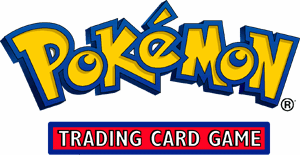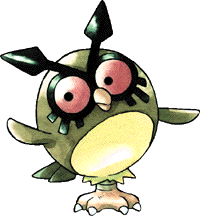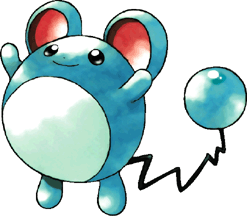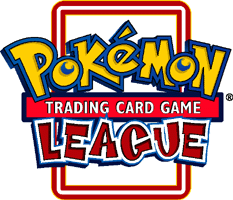 
What's
New in the Neo
Genesis
Expansion?
Baby
Pokémon cards: These are a special type of Basic
Pokémon card. They can evolve into other
Pokémon cards. For example, if Pichu evolves into
Pikachu, that Pikachu is an Evolved Pokémon, not a
Basic Pokémon card. If a Baby Pokémon is your
Active Pokémon and your opponent's Active
Pokémon tries to attack, your opponent flips a coin.
If tails, your opponent's turn ends without an
attack.
Darkness
( )
Pokémon and Metal ( )
Pokémon and Metal ( )
Pokémon: The Neo Genesis™ set has two
new types of Pokémon cards: Darkness ( )
Pokémon: The Neo Genesis™ set has two
new types of Pokémon cards: Darkness ( )
Pokémon and Metal ( )
Pokémon and Metal ( )
Pokémon. They have new Energy cards to go with them
(but not basic Energy cards - )
Pokémon. They have new Energy cards to go with them
(but not basic Energy cards -  and
and  Energy cards have special powers). The
Energy cards have special powers). The  Pokémon aren't the same as the Dark Pokémon in
the Team Rocket™ expansion. If a card refers to
a
Pokémon aren't the same as the Dark Pokémon in
the Team Rocket™ expansion. If a card refers to
a  Pokémon, it means one of these new Neo Genesis
Pokémon. If a card refers to "a Pokémon with
Dark in its name," it means a Team Rocket Dark
Pokémon.
Pokémon, it means one of these new Neo Genesis
Pokémon. If a card refers to "a Pokémon with
Dark in its name," it means a Team Rocket Dark
Pokémon.
Pokémon
Tools: These are a special kind of Trainer card that you
can attach to your Pokémon to help you. Each of the
Pokémon Tools says on it how it works. Each
Pokémon can have only 1 Pokémon Tool attached
to it at any time.
Expert
Rules Additions
With all of
the new cards in the Neo
Genesis expansion, the Expert Rules
have expanded to show you the
exact order in which certain
things happen. If you're a
beginning Pokémon®
player, don't worry about
these rules. But if you want
to be a Pokémon Master
Trainer, here are
the details!
New
rules additions
appear in red text below.
In
What Order Do You Do Your In What Order Do You Do Your
Attack?
 This
sequence has one new step. Before you do anything else (even
before you announce which attack you're using), if your
opponent's Active Pokémon is a Baby Pokémon,
flip a coin to see if your attack does nothing. For example,
say Charmander is your Active Pokémon and you want to
use its Ember attack. If your opponent's Active
Pokémon is a Baby Pokémon and you get tails on
the Baby Pokémon flip, you don't discard Energy cards
from Charmander to use Ember, because you won't even get to
the step in which you discard Energy. This
sequence has one new step. Before you do anything else (even
before you announce which attack you're using), if your
opponent's Active Pokémon is a Baby Pokémon,
flip a coin to see if your attack does nothing. For example,
say Charmander is your Active Pokémon and you want to
use its Ember attack. If your opponent's Active
Pokémon is a Baby Pokémon and you get tails on
the Baby Pokémon flip, you don't discard Energy cards
from Charmander to use Ember, because you won't even get to
the step in which you discard Energy.
 Announce
which attack your Active Pokémon is using. Make sure
your Pokémon has enough Energy cards attached to it
to use the attack. Announce
which attack your Active Pokémon is using. Make sure
your Pokémon has enough Energy cards attached to it
to use the attack.
 If
necessary, make any choices the attack requires you to make.
(For example, Natu's Telekinesis attack says "Choose 1 of
your opponent's Pokémon." So you choose now.) If
necessary, make any choices the attack requires you to make.
(For example, Natu's Telekinesis attack says "Choose 1 of
your opponent's Pokémon." So you choose now.)
 If
necessary, do anything the attack requires you to do in
order to use it. (For example, discard Energy cards, as in
Flaaffy's Discharge attack, which makes you discard all If
necessary, do anything the attack requires you to do in
order to use it. (For example, discard Energy cards, as in
Flaaffy's Discharge attack, which makes you discard all
 Energy cards attached to Flaaffy in order to use it.)
Energy cards attached to Flaaffy in order to use it.)
 If
necessary, apply any effects that might alter or cancel the
attack. (For example, if your Pokémon was hit last
turn by Lv. 35 Quilava's Smokescreen attack, that attack
said that if you tried to attack with that Pokémon
during your next turn, you should flip a coin. If tails,
your Pokémon's attack does nothing.) If
necessary, apply any effects that might alter or cancel the
attack. (For example, if your Pokémon was hit last
turn by Lv. 35 Quilava's Smokescreen attack, that attack
said that if you tried to attack with that Pokémon
during your next turn, you should flip a coin. If tails,
your Pokémon's attack does nothing.)
 If
your Active Pokémon is Confused, check now to see if
the attack fails. If
your Active Pokémon is Confused, check now to see if
the attack fails.
 Do
whatever the attack says. Do any damage first, then do any
other effects, and, finally, Knock Out any Pokémon
that have damage greater than or equal to their Hit
Points. Do
whatever the attack says. Do any damage first, then do any
other effects, and, finally, Knock Out any Pokémon
that have damage greater than or equal to their Hit
Points.
How
Do You Figure Out the Damage?
 Start
with the base damage. This is the number written to the
right of the attack, or, if that number has an x, -, +, or ?
sign next to it, it's the amount of damage the attack text
tells you to do. Start
with the base damage. This is the number written to the
right of the attack, or, if that number has an x, -, +, or ?
sign next to it, it's the amount of damage the attack text
tells you to do.
 Apply
any effects the Active Pokémon has that affect the
base damage dealt (for example, Base Set 2 Scyther's Swords
Dance). Then if the base damage is 0 (or if the attack
doesn't do any damage at all), just stop figuring the
damage. You're done now. Otherwise, keep going. Apply
any effects the Active Pokémon has that affect the
base damage dealt (for example, Base Set 2 Scyther's Swords
Dance). Then if the base damage is 0 (or if the attack
doesn't do any damage at all), just stop figuring the
damage. You're done now. Otherwise, keep going.
 Double
the damage if the Defending Pokémon has Weakness to
the attacking Pokémon's type. Double
the damage if the Defending Pokémon has Weakness to
the attacking Pokémon's type.
 Subtract
30 damage if the Defending Pokémon has Resistance to
the attacking Pokémon's type. Subtract
30 damage if the Defending Pokémon has Resistance to
the attacking Pokémon's type.
 Figure
out damage effects of Trainer cards and Energy cards on the
attacking Pokémon (like Base Set 2 PlusPower or
Darkness Energy). Figure
out damage effects of Trainer cards and Energy cards on the
attacking Pokémon (like Base Set 2 PlusPower or
Darkness Energy).
 Figuring
out the damage has one new step. That's figuring out effects
of cards that affect the whole play area (like Sprout Tower,
which says "All damage done by Figuring
out the damage has one new step. That's figuring out effects
of cards that affect the whole play area (like Sprout Tower,
which says "All damage done by  Pokémon's attacks is reduced by 30"). This happens
after you figure out effects of Trainer cards attached to
the attacking Pokémon, but before you figure out
effects of Trainer cards attached to the Defending
Pokémon.
Pokémon's attacks is reduced by 30"). This happens
after you figure out effects of Trainer cards attached to
the attacking Pokémon, but before you figure out
effects of Trainer cards attached to the Defending
Pokémon.
 Figure
out damage effects of Trainer cards and Energy cards on the
Defending Pokémon (like Base Set 2 Defender or Metal
Energy). Figure
out damage effects of Trainer cards and Energy cards on the
Defending Pokémon (like Base Set 2 Defender or Metal
Energy).
 Apply
any relevant effects resulting from the Defending
Pokémon's last attack (for example, Base Set 2 Onix's
Harden) or any relevant Pokémon Powers. Apply
any relevant effects resulting from the Defending
Pokémon's last attack (for example, Base Set 2 Onix's
Harden) or any relevant Pokémon Powers.
 For
each 10 damage the attack ends up doing, put 1 damage
counter on the Defending Pokémon. (If at this point
the damage done turns out to be less than 0, don't do
anything.) For
each 10 damage the attack ends up doing, put 1 damage
counter on the Defending Pokémon. (If at this point
the damage done turns out to be less than 0, don't do
anything.)
 Now that damage has been done, if the attack does anything
other than damage, do all of that.
Now that damage has been done, if the attack does anything
other than damage, do all of that.
In
What Order Do Things Happen after Each Player's
Turn?
Usually it
doesn't matter in what order you do things after each
player's turn, but if things get complicated, follow these
steps in order:
 a)
Put damage counters on any Poisoned Pokémon. a)
Put damage counters on any Poisoned Pokémon.
b) Flip to
see if Asleep Pokémon recover, and have Paralyzed
Pokémon recover.
c) Flip to
see if Pokémon with Char counters take damage.
d) Put
damage counters on any Pokémon with  Energy attached to them (except for
Energy attached to them (except for  Pokémon and ones with Dark in their names).
Pokémon and ones with Dark in their names).
If one of
 your
Pokémon has a Pokémon Tool attached to it and
that Pokémon Tool does something between turns, you
can use the Pokémon Tool at any time you want between
turns. your
Pokémon has a Pokémon Tool attached to it and
that Pokémon Tool does something between turns, you
can use the Pokémon Tool at any time you want between
turns.
If your
Pokémon and your opponent's Pokémon are
Knocked Out at the same time between turns, the player who
is about to take a turn replaces his or her Pokémon
first (and chooses his or her Prize first as well).



 ™
& ® Nintendo. ™
& ® Nintendo.
©1995-2000 Nintendo, Creatures, GAMEFREAK.
Presented by The Pokémon Company. Manufactured and
distributed by Wizards of the Coast, Inc.
*The Wizards of the Coast logo is a registered trademark of
Wizards of the Coast, Inc.
©2000 Nintendo.
HTML Conversion by
Philippe Van Lieu & Pokémon Aaah!. No harm was
meant in producing this. In fact, we'd prefer... no...
demand for you to actually download the original
.PDF file
from Wizards and not read this cheap HTML conversion. This
conversion was not endorsed by Nintendo,
Creatures, GAMEFREAK, or Wizards of the Coast.
|




 This
sequence has one new step. Before you do anything else (even
before you announce which attack you're using), if your
opponent's Active Pokémon is a Baby Pokémon,
flip a coin to see if your attack does nothing. For example,
say Charmander is your Active Pokémon and you want to
use its Ember attack. If your opponent's Active
Pokémon is a Baby Pokémon and you get tails on
the Baby Pokémon flip, you don't discard Energy cards
from Charmander to use Ember, because you won't even get to
the step in which you discard Energy.
This
sequence has one new step. Before you do anything else (even
before you announce which attack you're using), if your
opponent's Active Pokémon is a Baby Pokémon,
flip a coin to see if your attack does nothing. For example,
say Charmander is your Active Pokémon and you want to
use its Ember attack. If your opponent's Active
Pokémon is a Baby Pokémon and you get tails on
the Baby Pokémon flip, you don't discard Energy cards
from Charmander to use Ember, because you won't even get to
the step in which you discard Energy.
 a)
Put damage counters on any Poisoned Pokémon.
a)
Put damage counters on any Poisoned Pokémon.
 your
Pokémon has a Pokémon Tool attached to it and
that Pokémon Tool does something between turns, you
can use the Pokémon Tool at any time you want between
turns.
your
Pokémon has a Pokémon Tool attached to it and
that Pokémon Tool does something between turns, you
can use the Pokémon Tool at any time you want between
turns.

 ™
& ® Nintendo.
™
& ® Nintendo.